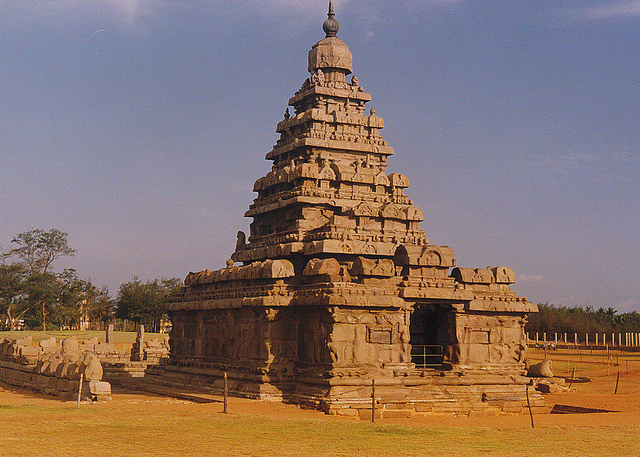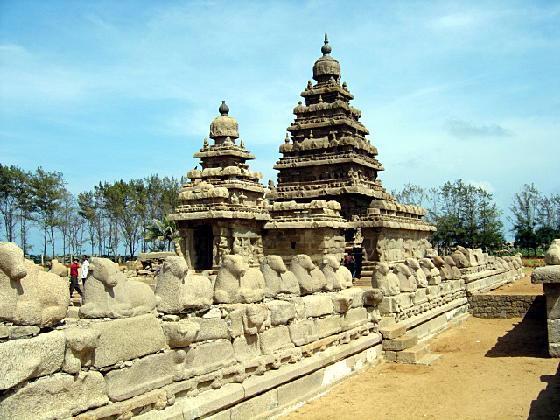Tourist Attractions
in Mamallapuram
|
|
The major tourist attractions in Mamallapuram are the Shore Temple, Mandapas, Five Rathas, Arjuna's Penance and Tiger's Cave. The sculpture in these temples is particularly interesting because it shows scenes of day-to-day life, in contrast with the rest of the temples, where the carvings depict only gods and goddesses. There were two low hills in Mahabalipuram, about 400 m from the sea. In the larger one, on both sides, there are eleven excavated temples, called Mandapas and two "open air bas
relief", one of which is unfinished and other is enclosed one. Out of the big rock stands nearby a "cut out" temple, called a "Ratha". These type of rathas are very unique in Mahabalipuram.
The other hill is much small and stands about 200 m to the south. On this hill are located five rathas, and three big sculptures of Nandi, Lion and an Elephant. On the top of the bigger hill there is a structural temple, the magnificent remainsof the Vijayanagar Gopura and a
palace.
|
 |
The Shore Temple
The Shore temple is located on a rocky hill very close to the sea. This is one of the oldest temples in South India. It belongs to the 8th century AD and is a good example of the first phase of structural temples constructed in Dravidian style. The structure of the temple is so unusual so that it can catch the first rays of the rising sun and to illuminate the waters after dark. As the main shrine faces the sea on the east, the gateway, the fore count and the assembly hall of the Shore Temple all lie behind the sanctum. The beautiful shore temple consists of two temples dedicated to Lord Shiva and Vishnu in the reclining form. The main sanctum and one of the two lesser ones on the west are dedicated to Shiva. The enclosing wall has a series of Nandi bulls on it. Recently, a stone wall has been built to protect the shrine from the rising seas and further erosion. The temple is flood lit at night so that one can enjoy its beauty after sunset.
Rathas
The eight rathas are the monolithic temples built in a chariot style. These rathas will always remain an architectural mystery, as each of these rathas are a faithful reproduction of a structure built of wood. Each of these rathas are dedicated to a particular god or goddess. Stone animals represent the vehicle of the god. Out of the eight rathas, four rathas are supposed to have been scooped out of a single rock formation. The five rathas have been named after the Pandava brothers, the heroes of the epic Mahabharata, and their shared wife, Draupadi. The largest ratha is the Dharmaraja ratha and it sets the tone for the others. This ratha is modelled on a Buddhist vihara or monastery, and support a square hall topped by a vaulting roof. The Bhima, Arjuna and Nakula Sahdeva rathas are the lesser copies of the Dharmaraja ratha. The Draupadi ratha is the smallest and the quaintest. It is simple structure, built as a thatched hut borned on the back of elephants and lions. It was probably the fascimile of a portable village shrine. The Nakula - Sahadeva Ratha is a two storeyed vimana. This ratha is located beside an elephant which is the mount of Indra and suggests its dedication to the rain god.
Many of the temples and sculptures of Mamallapuram are unfinished due to the sudden withdrawal of patronage from rock-cut temples when King Rajasimhavarman
came to power.
Mandapas
The main hill at Mamallapuram is dotted with pillared halls carved into the rock face. These mandapas, with their graceful columns and intricate figure sculptures bear witness to the Pallavas. The ten pavilions at Mamallapuram, of which two are unfinished, were designed as shrine, with a sanctum and one outer hall. The shallow porticoes are adorned with exquisite sculptures of gods, goddesses and mythological figures. The main active shrine is the Ganesh mandapa, with the idol of the Lord Ganesha standing for almost fourteen centuries after it was first constructed.
Beyond the circular rock called Krishna's Butterball is the Varaha mandapa dedicated to the two avatars of Vishnu as Varaha, the boar and Vamana, the dwarf. The pillars of this pavilion display a motif that became the signature of the southern architecture. The Mahishasuramardini mandapa is dedicated to the goddess Durga in bas relief, slaying a buffalo-headed demon. The Vishnu Sayana Mandapa shows Lord Vishnu lying under the protective hood of the seven-headed serpent Adishesha. The Panch Pandava mandapa,
that is unfinished, has a more elaborate facade. Its
pillars are adorned with rearing lions springing from
the capital, and the shrine is the only one surrounded
by a passage which allows circumvolutions.
Tiger Cave Temple
The Tiger Cave Temple is located 4 kms north of the main monument complex. Earth and animal life forces are represented in this great example of Pallava style cave architecture. The temple was earlier an open air theatre, where cultural programmes
were held. Though it is very near the sea, the place
is very serene and calm. |
 |
Other temples
The Mahishamardini cave temple has several bas relief panels with scenes from the Puranas. The north panel features the goddess Durga with eight arms and riding on a lion in battle with the buffalo headed demon
Mahishasura. The triple celled temple is dedicated to the Trinity of the Hindu pantheon, the Lord Brahma, Lord Shiva and Lord Vishnu. A single cell is dedicated to each deity. The temple is an example of King Narasimha style.
Kanchipuram
Kanchipuram lies west of Mamallapuram. This temple town was the capital of the Pallava dynasty. Kanchipuram is well known for the famous silk
saris which are produced here and well known throughout the world.
Arjuna's Penance
Arjuna's Penance is the largest bas relief sculpture in the world. This structure has been skillfully carved out of a single rock. It gets its name from the figure of an ascetic who is believed to be Arjuna, the hero of Mahabharata. The Arjuna performed a penance in order to obtain an arrow from Lord Shiva. Some other people also believe that the figure is actually of Bhagiratha who entreated Siva to let the river Ganges flow over the earth. Arjuna can be seen here standing on his left leg. The event is witnessed by creatures from heaven, earth and the underworld.
Vedanthangal
Vedanthangal is one of the major water bird sanctuaries in India. The birds migrate here every year from November to February from all over the world. |
|
|
|
|
|